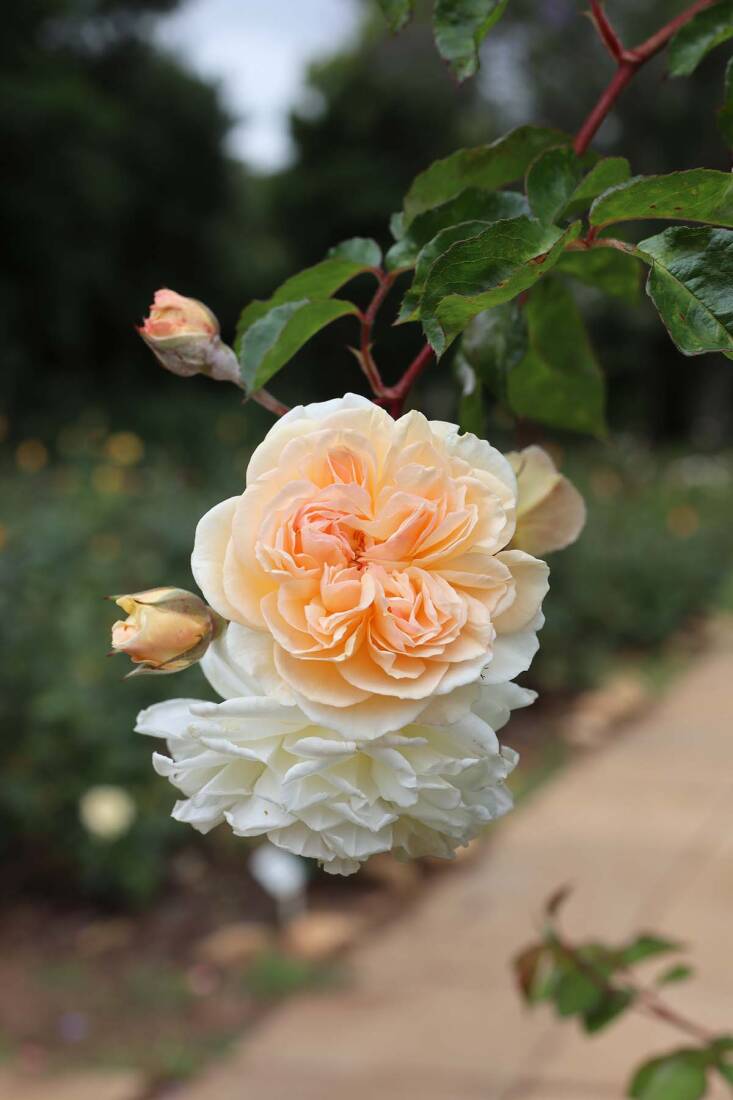For Capetonians who love flowers, a rite of summer passage is a visit to Chart Farm, where visitors may pick roses from rows and rows of long-stemmed hybrid teas. The rose garden of this suburban farm is planted on the gentle slopes of Cape Town’s Wynberg Hill with a wide, green view across the the Constantia Valley. Vineyards and fig trees meet the garden’s southeastern border, and a Sir Herbert Baker-designed homestead presides over the garden to the north. Statuesque palms and stately Magnolia grandiflora trees convey a sense of vintage tranquility. It’s an insider’s escape for city dwellers. Besides yielding a beautiful bouquet, the pick-your-own approach doubles as immersive horticultural therapy, deeply appealing in our digitally powered lives.
Photography by Marie Viljoen.

Rose season in Cape Town begins in their late spring (around mid-September) and peaks in October and November. While the long-limbed roses at Chart Farm follow that schedule, they are chosen, and were bred for, their ability to repeat-bloom. Visiting at any time in summer and through late autumn (April and May) will yield a beautiful bouquet.

The ideal time to cut roses is in the cool of the morning. But even when picked later in the day, they will last better if placed into a bucket of shallow water as you walk and snip. Visitors can bring along their own secateurs and buckets, but the farm provides those for no fee, as long as you are willing to hand over your car keys in exchange. It seems fair. Nobody likes losing their pruners.

Most of the roses at Chart Farm are planted one cultivar to a row, and most are hybrid teas (meaning one stem, one flower, versus floribundas, which are multiple flowers per one stem). Many were developed by Ludwig’s Roses, a South African rose-breeding and growing company founded in Pretoria by German immigrant Ludwig Taschner in 1971. In partnership with international rose breeders, Ludwig’s also tests new roses for South African conditions, which vary widely. The company pioneered the container-grown (versus bare-root) rose trade in the country. The cutting garden here was designed and planted with their assistance. Since 2014 visitors been able to purchase Ludwig’s roses on site from a nursery managed by David Molautsi, whose expert rose-growing advice seems bottomless and is shared gratis.

All roses have stories. ‘Margaret Wasserfall’ was cultivated in 1993 by the German rose growers W. Kordes and Sohne from a crossing of ‘Antique Silk’ with a nameless seedling and named after the then-editor of the South African magazine Garden and Home.

The glory of the roses at Chart Farm is that there is a bloom to suit almost every taste and generation. I was never a fan of electric orange roses. But my father was. And so for his 80th birthday years ago I swooped down on the farm with a friend to pick bucketsful to grace the tables for a very big party.

Admittedly, I added many other blooms to offset the wildness of the neon buds. (The agapanthus, alstroemeria, and star jasmine came from my mother’s garden.)

Not all the shrubs at Chart Farm are regimented by row: Some are planted in more gentle flower beds, which give local gardeners a sense of how they would appear in their own spaces. A chart at Ludwig’s Nursery on site helps decipher the mystery of their bloom shapes: deep cups, shallow cups, open cups, quartered rosettes, classic hybrid teas, single, semi-double, pompom, and rosette. It’s dizzying and delicious. (Bees like single roses, as well as shallow and open cups, because they can reach the pollen at the flower’s heart.)

Some of the roses are distinctly old-fashioned in appearance, despite their modern parentage. ‘My Granny’ is a repeat-blooming, spreading rose that makes an exquisite hedge. South African gardeners sometimes choose plants with security in mind, and a deterrently thorny hedge that also flowers is doubly appealing.

One of the benefits of having pruner-armed visitors slicing their way down rows of hundreds of roses is that it is essentially free pruning. Or, rather, people paying to prune. Roses relish being cut back. Ludwig Taschner’s no-nonsense advice regarding pruning (for nervous gardeners) is that there’s no such thing as a wrong cut. Any cutting back is helpful.

Once you’ve chosen the roses you want, an old cement trough in the lawn is a rustic staging area where you can neaten up the flower stems, clip off any egregious thorns, and strip leaves that might be below the waterline in the container you will use.

And then it is time to pay. Stems you cut yourself are R7, the equivalent of about 45 US cents. If you don’t have your own container, the roses will be wrapped for you in a sheaf of newspaper. Or you can buy already-cut and prepped stems if you’re in a hurry. The payment window doubles as a local farm stall, where boxes of impeccable cherries are sold from October to December (the farm’s owners, the Garlick family, also own Klondyke Cherry Farm and its pick-your-own cherry orchards) as well as local preserves, and, in late summer and autumn, the farm’s own figs, hanepoot grapes, and chestnuts. Next door, The View coffee shop and restaurant does indeed offer a gorgeous view, but—insider tip—excruciatingly slow service.

Whether you are picking loads of roses for a party, a bunch for a friend, or just want a taste of local Cape Town life (with a side of overblown fragrance for your Airbnb), Chart Farm is a retreat within reach.









Have a Question or Comment About This Post?
Join the conversation